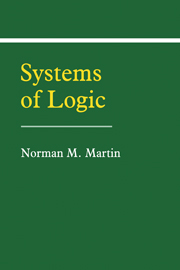Book contents
- Frontmatter
- Contents
- Preface
- 1 Formal Systems and Structure Theory
- 2 Zero-Order Logic: Proof Theory
- 3 Zero-Order Model Theory
- 4 Positive Implication
- 5 Negation
- 6 Complete Implication-Negation Logic
- 7 Disjunction
- 8 Conjunction
- 9 Multi-Connective Systems
- 10 Strict Implications: Introduction
- 11 Strict Implications: Additional Results
- 12 Quantification and First-Order Logic
- 13 Quantification and Complete Logics
- 14 Quantification and Incomplete Logics
- 15 Interpretation of Formal Systems
- Appendix: Historical and Bibliographical Remarks
- Subject Index
- Index of Systems
- Index of Symbols
3 - Zero-Order Model Theory
Published online by Cambridge University Press: 12 March 2010
- Frontmatter
- Contents
- Preface
- 1 Formal Systems and Structure Theory
- 2 Zero-Order Logic: Proof Theory
- 3 Zero-Order Model Theory
- 4 Positive Implication
- 5 Negation
- 6 Complete Implication-Negation Logic
- 7 Disjunction
- 8 Conjunction
- 9 Multi-Connective Systems
- 10 Strict Implications: Introduction
- 11 Strict Implications: Additional Results
- 12 Quantification and First-Order Logic
- 13 Quantification and Complete Logics
- 14 Quantification and Incomplete Logics
- 15 Interpretation of Formal Systems
- Appendix: Historical and Bibliographical Remarks
- Subject Index
- Index of Systems
- Index of Symbols
Summary
In this chapter, we will present an alternative way of characterizing zeroorder logics. In some of its instances, this new way will be familiar to the reader with experience in elementary symbolic logic as “truth functional” logic. As we shall see, our characterization will be somewhat more general than the usual presentation. It is, however, in an important sense not as general as it might be. The overall methodology, as we shall see, consists of defining a class of mathematical structures which, when they are playing this role, are called model structures. One then defines a relation, analogous in some sense to “truth,” between wffs and model structures; this relation is usually called satisfaction. Substantial parts of the theory then are not specific to the particular version of satisfaction we will introduce in this chapter but are relative to whatever structures and “satisfaction” are used. We will indeed introduce a few of these alternatives in chapter 11. In this chapter (and in chapter 12), we will be addressing perhaps the mathematically simplest of these: those which have the variables ranging over arbitrary sets and which copy the functional structure of the logics over which they are defined. When necessary we will refer to this family of model theory as “extensional model theory.”
- Type
- Chapter
- Information
- Systems of Logic , pp. 38 - 56Publisher: Cambridge University PressPrint publication year: 1989



